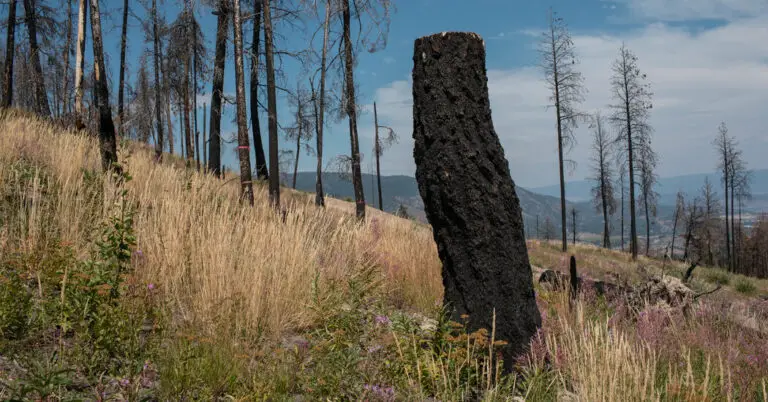Blazing Flames Halted by Clever Move: A Tale of Wildfire Survival
Imagine a furious wildfire marching straight toward a picturesque Canadian lakeside haven with 222,000 folks in British Columbia. Now, picture this fiery rampage coming to a screeching halt, right at the doorstep of the city. Sounds like a plot twist in a nature horror movie, right?
Well, this real-life drama played out in Kelowna, where a blazing inferno advanced for 19 days, gobbling up a staggering 976 hectares (that’s about 2,400 acres) of forest. Yet, just when it seemed like the city was toast, the fire got all choked up at the fringes and fizzled out, sparing all but one house.
You might wonder, how did Kelowna’s guardian angels pull off this stunt? They used something called a “fire prevention zone,” kind of like a moat to keep the flames at bay. This smart zone, cleared by a local Indigenous community’s logging company, worked like magic, stopping the blaze in its tracks. It turns out that the Mount Law fire of 2021 had an important lesson hidden in its smoky folds: these fire prevention zones are like superhero capes, protecting homes and lives.
This isn’t just a superhero story for Kelowna; it’s a tale that’s gaining traction across Canada and beyond. As climate change tosses more fiery tantrums, places need to get crafty to beat back the blazes. Kira Hoffman, a wildfire researcher, dropped a truth bomb: “If we put our money where the fire isn’t, we’ll be sitting pretty in the future.”
Wildfires are nature’s way of hitting the reset button in forests. But lately, they’ve grown unruly, like toddlers who discovered the cookie jar. That’s where fire prevention zones step in, like wise old babysitters. These zones are like speed bumps for fires, giving people time to flee and firefighters a fighting chance.
Canada’s facing a wildfire explosion, burning ten times more land than last year. The flames have even sent smoke on vacation, reaching as far as Georgia and Europe. Picture Europeans rubbing their eyes, blaming jet lag, but it’s just Canada saying “Hi!”
But wait, there’s a twist! The current fire in West Kelowna wasn’t impressed by prevention zones and took a fiery stroll through unprotected areas, munching on 110 buildings and sending 30,000 folks packing. A fire-resistant zone, the hero of 2021, saved the day by starving the flames and high-fiving firefighters.
The lumberjack heroes at Ntityix Development, owned by Westbank First Nation, aren’t just chopping wood; they’re rewriting the rules. They’ve brought traditional Indigenous forest know-how to the party, thinning forests, tidying up debris, and even throwing a controlled burn party for the leftover junk. Back in the day, the province wouldn’t have let them do it, but now they’re the cool kids on the block.
Dave Gill, the forest general manager, called it a success while strolling through the still-standing forest. Imagine him strutting like a peacock, saying, “Yeah, it stopped advancing. Nailed it!”
Their secret? Making forests less flammable, so airborne fire embers are like, “Hey, where’s the party?” A former firefighter turned researcher, Dr. Hoffman, gave them a thumbs-up.
Mr. Gill’s journey started in 2015, six years before Mount Law’s fiery tantrum. He created the Glenrosa project, like naming your project after a cool neighborhood. The aim? Keep the fire on the ground, where it’s easier to tame.
They even gave tree fashion a makeover, saving the mature, snazzy trees with fire-resistant bark, and giving the young, combustible ones a timeout. It’s like a runway show, but with trees. Instead of chopping all the trees down, they pruned some so they don’t become ladders for fire. The debris got a makeover too, getting chipped, trucked, or burned, instead of adding fuel to the fire’s rave party.
This approach isn’t just a fad; it’s a new way of thinking. Mr. Gill had a long government and forestry career before this aha moment. Now, he’s like a forest whisperer, hearing the elders’ advice on a 120-year playlist.
Some skeptics think wildfires will just do whatever they want, no matter how hard we try. But Dr. Hoffman’s like, “Not so fast.” She’s got hope that with enough effort, we can pull the brakes on these fiery tantrums.
But let’s be real, this isn’t a glamorous gig. It’s not like anyone’s winning Oscars for removing 6-inch pine from the forest. Still, Ntityix and other Indigenous-led crews are out there, sweating it out to save homes, lives, and trees.
It’s not cheap, and it takes time. Ntityix is dropping $100,000 a year into this fiery fight. Craig Moore, part of the Syilx Okanagan Nation, is in on it too, doing his part to keep water and trees alive. If they go, we go too.
So, next time you see someone pruning trees or clearing debris, give them a nod. They might not be flashy, but they’re the unsung heroes keeping our forests and homes safe.

